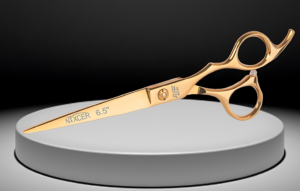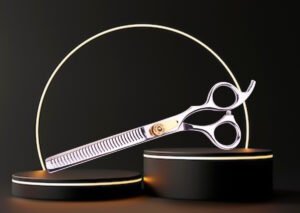1. Types: Hair Cutting Scissors for Tapering
Tapering is all about creating a smooth transition between different hair lengths, usually seen in fades, layered haircuts, and other styles that require blending. The type of scissors you choose greatly impacts the outcome.
Thinning Scissors: Thinning scissors are specifically designed to reduce bulk and soften hard lines in haircuts. They have one blade with teeth and another with a straight cutting edge, which allows for partial hair removal with each cut. This selective cutting action is perfect for creating softer, blended looks without making the hair look choppy. Thinning scissors are great for tapering because they help distribute hair weight evenly, resulting in a gradual transition.
Blending Scissors: Blending scissors are a type of thinning scissors but are specifically tailored for creating seamless blends in hair. They are often used to refine and finish haircuts by softening the transition between different hair lengths. These scissors are especially helpful in tapering near the nape, around the ears, and other areas where a subtle blend is needed.
2. Blade Design: Hair Cutting Scissors for Tapering
The blade design directly affects how the scissors cut hair, which is crucial when tapering. Here’s what to look for.
Convex Edge Blades: Convex blades are known for their razor-sharp edges, making them perfect for precise, clean cuts. These blades allow for a smooth, gliding motion, which is essential when performing techniques like point cutting, slicing, or tapering. Convex edge blades offer the sharpness required to execute delicate tapering cuts without tugging or pulling hair, providing a polished finish.
Beveled Edge Blades: While beveled blades are common, they are less sharp compared to convex edges and are typically used for basic cutting. For tapering, convex edges are preferred due to their superior sharpness and cutting accuracy.
Serrated Blades: Blades with tiny serrations help grip hair while cutting but can leave rougher edges, making them less suitable for tapering. Tapering requires clean, smooth cuts, which are best achieved with non-serrated, sharp blades.
3. Teeth Configuration: Hair Cutting Scissors for Tapering
The teeth on thinning and blending scissors play a crucial role in how much hair is removed with each cut, influencing the tapering effect.
Number of Teeth
Scissors with fewer teeth (15-20) remove more hair with each cut, which can create a chunkier look. These are better suited for quick bulk removal rather than detailed tapering.
Scissors with more teeth (30-40) remove less hair with each cut, providing a softer, more controlled tapering effect. The higher the number of teeth, the more refined the blending process, which is ideal for tapering near the hairline or blending layers smoothly.
Tooth Spacing
Wider teeth spacing can quickly reduce volume but may not provide the finesse needed for detailed tapering.
Closely spaced teeth are excellent for finishing touches and fine blending, making them more suitable for tapering work.
4. Scissor Length: Hair Cutting Scissors for Tapering
Scissor length affects the control and ease of handling when tapering.
Shorter Scissors (5.5-6 inches): These are great for detailed work close to the head, such as tapering around the ears, necklines, and for precision layering. They allow you to maneuver easily in tight spaces, giving you the control needed for intricate tapering cuts.
Longer Scissors (6.5-7 inches): While primarily used for scissor-over-comb techniques, which are also a part of tapering, these can be slightly harder to control for detailed tapering work compared to shorter scissors. However, they can be beneficial when blending longer sections.
5. Handle Design: Hair Cutting Scissors for Tapering
The handle design of your Professional hair cutting scissors plays a significant role in ergonomics, especially if you spend long hours cutting hair.
Offset Handles: Offset handles are designed to reduce hand and wrist strain by positioning the thumb in a more natural position. This ergonomic design is particularly beneficial when performing repetitive tapering movements.
Crane Handle: Crane handles provide maximum comfort and reduce thumb and shoulder movement, which helps you maintain a more relaxed hand position. This design allows you to keep your elbow down, reducing strain and allowing more precise control during tapering.
Classic Handle: Classic straight handles can cause more strain on your hand and wrist during tapering because they do not provide the same ergonomic benefits as offset or crane handles.
6. Material and Quality: Hair Cutting Scissors for Tapering
The quality of the material used in the scissors affects sharpness, durability, and cutting performance.
High-Quality Steel: Scissors made from high-carbon stainless steel or Japanese steel are known for their superior sharpness and longevity. These materials resist corrosion and maintain their edge longer, which is essential for consistent tapering results.
Titanium Coating: Some scissors feature a titanium coating that adds an extra layer of durability, reduces friction, and enhances smooth cutting action. This helps in achieving clean tapering cuts without hair catching or dragging.
7. Adjustable Tension System: Hair Cutting Scissors for Tapering
The tension system of scissors allows you to adjust how tightly the blades come together, impacting the smoothness and control of your cuts.
Adjustable Tension Screw: Scissors with an adjustable screw allow you to fine-tune the tension to suit your cutting style and hair type. Proper tension ensures that the blades move smoothly against each other, making tapering cuts more effortless and precise.
Ball Bearing Tension System: Some high-end scissors come with a ball bearing system that provides even smoother operation and reduces wear on the blades. This can be particularly beneficial for professional stylists who do a lot of tapering work.
8. Weight and Balance: Hair Cutting Scissors for Tapering
The weight of the scissors affects the ease of maneuvering, especially during detailed tapering.
Lightweight Scissors: Opt for lightweight scissors as they reduce hand fatigue, making it easier to perform precise tapering cuts over long periods. Balanced scissors allow for better control, enhancing the accuracy of your tapering techniques.
9. Price and Brand: Hair Cutting Scissors for Tapering
Investing in a quality pair of scissors is crucial for achieving the best tapering results.
Reputable Brands: Brands like Joewell, Yasaka, Matsui, and Mizutani are known for their quality and precision. While these brands might be on the higher end of the price spectrum, they offer excellent durability and performance, making them worth the investment for serious stylists.
Price Range: Depending on your budget, you can find good-quality tapering scissors in various price ranges, but it’s advisable not to compromise too much on quality, as better scissors lead to better results.
10. Maintenance: Hair Cutting Scissors for Tapering
Maintaining your scissors is crucial for their longevity and continued effectiveness, particularly for precision tasks like tapering.
Regular Cleaning: Clean your scissors after every use to remove hair and residue, which can dull the blades.
Sharpening: Periodically sharpen your scissors to maintain their cutting performance. Dull scissors can cause uneven cuts and damage hair, making precise tapering difficult.
Oiling: Regularly oil the pivot area to ensure smooth opening and closing of the blades, which helps maintain precise cutting action.
Final Thoughts
Selecting the right hair cutting scissors for tapering involves a combination of choosing the right type of scissors, considering blade design, teeth configuration, handle ergonomics, and overall quality. For best results, opt for thinning or blending scissors with convex edges, ergonomic handles, and high-quality steel. Proper maintenance will keep your scissors in top condition, allowing you to perform perfect tapering cuts every time. Investing in the right scissors not only enhances the quality of your work but also provides comfort and control, leading to consistently excellent tapering results.



